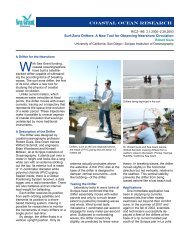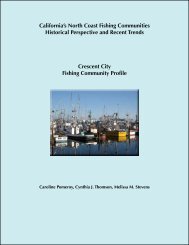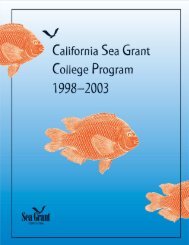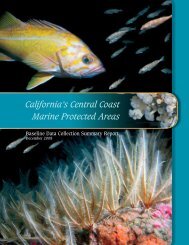2001â2002 - California Sea Grant - UC San Diego
2001â2002 - California Sea Grant - UC San Diego
2001â2002 - California Sea Grant - UC San Diego
Create successful ePaper yourself
Turn your PDF publications into a flip-book with our unique Google optimized e-Paper software.
fall chinook over a 23-year period as habitat changes occurred.<br />
The Smith River in Del Norte County is the most pristine<br />
undammed river in <strong>California</strong>. It is host to excellent salmon and<br />
steelhead populations and serves as a benchmark for salmonid<br />
habitat and effective management. This research project is providing<br />
a long-term database to guide fishery managers on the Smith<br />
River system. The chinook spawning population is monitored<br />
weekly from November through February, and an annual age<br />
composition is determined from scale analysis. Fluctuating chinook<br />
populations are reflecting drought effects, ocean habitat and feeding<br />
conditions (El Niños and upwelling), and some habitat changes.<br />
The salmonid database from this long-term study was used in<br />
1993 to deter a proposed state highway project that sought to<br />
relocate Highway 101 into portions of the Mill Creek drainage.<br />
Denial of this proposal was based on the high salmonid fishery<br />
values of Mill Creek and saved <strong>California</strong> taxpayers over $30<br />
million.<br />
Between 2000 and 2002, there were more spawning chinook<br />
than in any of the previous 23 years. Waldvogel attributes this to a<br />
Marine Advisor Jim Waldvogel has been counting chinook salmon and their<br />
shift in the phase of the Pacific Decadal Oscillation. This new phase,<br />
carcasses in the Smith River in Del Norte County for more than two decades.<br />
which could last some 30 Photo: <strong>California</strong> <strong>Sea</strong> <strong>Grant</strong> Extension Program<br />
years, is associated with<br />
cooler than normal ocean water<br />
temperatures in <strong>California</strong>,<br />
increased upwelling and enhanced<br />
coastal productivity.<br />
Though favorable to <strong>California</strong> salmon, the shift could reduce Alaska<br />
salmon numbers.<br />
In 2001, the 22-year fishery database allowed the landowner, Stimson<br />
Lumber Company, to negotiate a $60-million sale for the 25,000 acres of<br />
the Mill Creek watershed to Save-the-Redwoods League. Almost $20<br />
million of the land value was attributed to the <strong>Sea</strong> <strong>Grant</strong> long-term salmonid<br />
study that documented coho and chinook abundance estimates. The<br />
Save-the-Redwoods League has since turned ownership of the land over to<br />
the <strong>California</strong> State Parks, preserving this resource for future <strong>California</strong>ns.<br />
Waldvogel’s salmon count, the longest on record in the area, will be an<br />
important piece of fish resource information as the state develops a<br />
35











